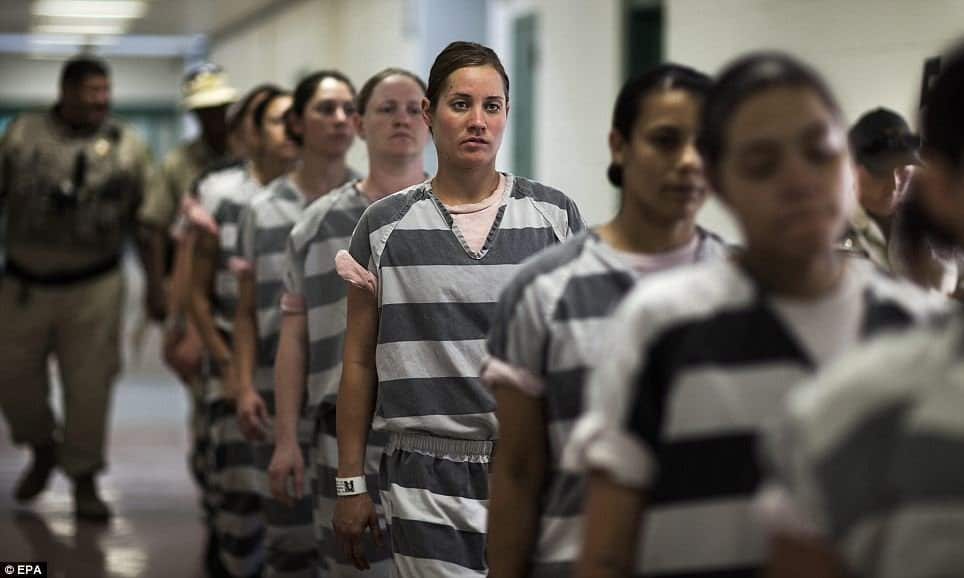
Last week, smack dab in the middle of Sexual Assault Awareness Month, the Department of Justice released a report about sexual violence in New Jersey’s women’s prison, the Edna Mahan Correctional Facility, that concluded that the risk of sexual harm was so high that it reached constitutional proportions and violated inmates’ Eighth Amendment rights against cruel and unusual punishment.
The DOJ report tells stories of women who were forced into indignities such as being forced to perform oral sex or having to serve as the lookout for their assailant as they were being raped.
What’s occurring at the Edna Mahan Correctional Facility is close to what happened at the Julia Tutwiler Prison for Women in Alabama, another women’s prison that the Department of Justice investigated in 2014.
Reading both of the reports, the New Jersey and the Alabama prisons could be the same place: women being called “bitches” and “ho’s,” coerced into performing oral sex on male guards. This level of sex and chaos might be labeled some type of oddly-situated bacchanalia if women’s survival and freedom—women are threatened with parole-busting discipline reports if they don’t comply with sexual demands—weren’t in the balance.
The rampant abuse at the New Jersey and Alabama prisons should be outliers but they’re not. The United States is witnessing an explosion in prison rape reports by women. In Missouri, no fewer than five federal lawsuits have been filed against the Chillicothe Correctional Center by incarcerated women; at least nine women have accused one therapist of sexual abuse.
Eight suits are pending against Coffee Creek Correctional Facility and the Oregon Department of Corrections for one nurse who allegedly abused, raped or sodomized more than 15 women while he worked there. A woman in Connecticut prison where I was housed (I worked with her) is suing the state for assaults by multiple male officers.
At least 12 officers have been accused of sexual misconduct at the Chittenden Regional Correctional Facility in Vermont. In Florida, too, women say sexual abuse is rampant in the Coleman Federal Detention Facility. It’s also happening in California, Kansas and Pennsylvania.
Incarcerated women are 30 times more likely to be raped than free women. Even though women account for less than 10 percent of inmates, their reports account for three quarters of assaults, and almost three-quarters of staff are men.
Passed in 2003, the Prison Rape Elimination Act (PREA) insists that correctional facilities of any type institute zero tolerance policies and implement various procedures to both prevent and monitor sexual violence within. Seventeen years after the law’s passage, it may be time to acknowledge that the Prison Rape Elimination Act isn’t protecting incarcerated women, most likely because it was never designed to.
For such a pressing issue, PREA’s implementation was rather slow: The National Prison Rape Elimination Commission didn’t form until 2009 and Former Attorney General Eric Holder missed the deadline to implement the commission’s standards. Those standards—the National Standards to Prevent, Detect and Respond to Prison Rape—didn’t go into effect until 2012, nine years after its passage.
Lawmakers have understood the risk of sexual violence against prisoners for years but as long any specialized attention was paid to women, Congress failed to act.
Inspired by a Human Rights Watch report about sexual abuse in female prisoners in 1996 entitled, “All Too Familiar: Sexual Abuse of Women in U.S. State Prisons,” a bill introduced by the late Congressman John Conyers, Jr. (D-MI)—himself ousted from his seat representing the 13th district of Michigan in 2017 for alleged sexual misconduct—sought to establish a list of staff who sexually abused inmates, an internal registry of correctional sex offenders.
Conyers’ bill, called the Custodial Sexual Abuse Act, was folded into the Violence Against Women Act of 1998. Unfortunately that version of the bill never made it out of committee. Sponsors eventually removed protection for female inmates from the reauthorization of the Violence Against Women Act when, tellingly, prison guards unions opposed it. The version of the Violence Against Women Act that eventually passed offers incarcerated women nothing.

Congress responded much more quickly when another report by Human Rights Watch called “No Escape: Male Rape In U.S. Prisons”—one that addressed the sexual violence against incarcerated men—reached legislators’ desks. As Washington College of Law Professor Brenda V. Smith put it:
“Society takes as a given that women will be victimized both in the free world and in custody, [so] the image of male rape was much more disturbing to members of Congress.”
Shortly thereafter, co-sponsors former attorney general and senator Jeff Sessions and the late Ted Kennedy introduced a bill that addressed only male inmates. Inside of 60 days, they oversaw hearings and sped the bill through the House of Representatives and under then-President George W. Bush’s pen.
That PREA might have safeguarded incarcerated women from sexual violence was just a beneficial side effect of saving men, particularly white men, from rape. Much of the focus of the highly prioritized bipartisan legislation was the risk to white male prisoners who were minorities in carceral settings. The idea of female inmates being assaulted and harmed by male staff has been disregarded as “politically correct” feminist piffle (p.504).
Even though the law has been in effect for almost two decades, the unique threat of sexual assault to women by their jailers seems to matter less as time goes on, if that’s even possible. It’s been almost two years since the Bureau of Justice Statistics released the first set of numbers about incidence of prison sexual assault since the PREA’s National Standards To Prevent, Detect and Respond to Prison Rape went into effect more than seven years ago. The 2018 report showed that rates of sexual behind bars had tripled between 2011 and 2015.
Experts and statisticians chalk up the increased rates to an improved confidence in prisoners that their reports would be taken seriously. That is, the incidence rates aren’t increasing but reporting and detection rates are.
But the new DOJ report betrays that theory. Women openly admitted to investigators that they’re frightened to reveal what happens to them for fear of retribution; one woman in New Jersey who turned in a sergeant for pressing his penis against her backside was placed in solitary confinement. With institutional responses like this, even the tripling rates probably reflect severe underreporting.
Aside from the stories that surface in litigation and targeted Department of Justice investigations, we have no idea if sexual violence is affecting women more than men. When it was released in 2018, none of the Bureau of Justice Statistics’ data on the implementation of PREA standards was broken down by gender. That breakdown was due one year later, last summer, but a miscalculation by one state required a recalculation of the entire data set. To date, there’s no plan to release the recalculation. Indeed, the error within the 2018 data release has never been formally announced.
That women are being serially abused—again, in another state—is a story that may not get the social media traction it deserves, even during a MeToo era, because it’s unrelated to the COVID-19 pandemic; so far, prison focus lands on the spread of the novel coronavirus inside.
But I’m glad that this story broke during this health crisis because it provides a good foil to the acute problems facing correctional facilities right now. Women in prison, their physical and mental safety, exist in chronic peril and that trauma escapes and spreads like a virus in the form of recidivism and compromised mental health.
The news this month is that the problem of prison rape, mainly for women, is epidemic and we’re doing very little about it.
The coronavirus pandemic and the response by federal, state and local authorities is fast-moving. During this time, Ms. is keeping a focus on aspects of the crisis—especially as it impacts women and their families—often not reported by mainstream media. If you found this article helpful, please consider supporting our independent reporting and truth-telling for as little as $5 per month.





